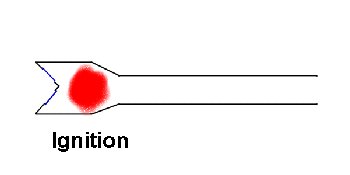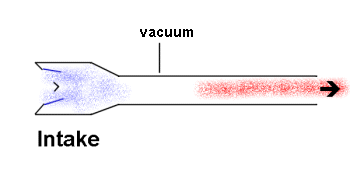Jet engine technologies for interested amateurs
Last Updated: 9 June, 2001
|
An Explanation Pulsejets are very simple engines but their operation is not always easily understood -- after all, how can an almost empty pipe run as a jet engine? This page is an attempt to explain the four basic phases in the pulsejet's operational cycle.
1. Ignition 
The effect is that a fireball is produced inside the engine which creates a great deal of heat and pressure. The reed valves are held closed by this pressure, effectively leaving the flame and hot gasses only one place to go...
2. Combustion 
During this phase the burning gases expand and travel down the tailpipe, exiting at the rear of the engine. The force of the gases leaving the engine in a rearwards direction creates an equal and opposite force that tries to move the engine forwards -- this is thrust.
3. Intake
This causes a partial vacuum to be created inside the engine.

The effect of this vacuum is to draw air and fuel in through the valves at the front of the engine -- which are pushed open by the higher pressure outside the engine.
4. Compression 
Once again, because they have momentum, the gases in the tailpipe continue to move even after the pressure inside and outside the engine is equalized. This means that the gases continue heading towards the front of the engine -- towards the fresh charge of air and fuel that has just been drawn in. Of course, as soon as the pressure inside the engine becomes higher than the air pressure outside, the reed valves slam shut -- stopping the air/fuel mixture from escaping. This continued movement of the exhaust gases causes the air-fuel mixture to be compressed -- until the hot gases finally travel so far up the pipe that they touch the explosive air/fuel mixture and -- back to step one! This cycle repeats hundreds of times a second -- producing the characteristic buzzing sound of the pulsejet engine.
What Can Go Wrong? Here are the effects of a few design mistakes that can affect the engine's ability to run:
It can be seen from this that there are two critical elements to designing a successful pulsejet engine:
Designing A PulseJet I hope to add a "design your own pulsejet" section to this website shortly. Stay tuned!
|
|
